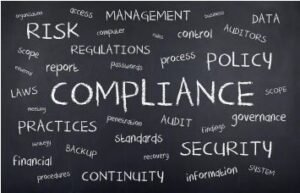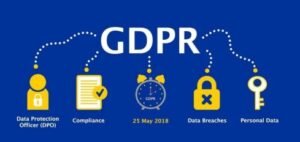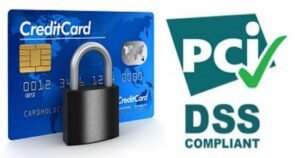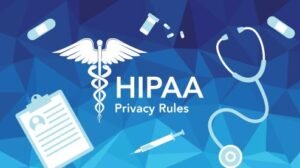PREPARED BY: Mirza Azfar Baig Chief Executive Officer CANSOL CONSULTING (PVT) LTD.
Security Compliance: Adhering to security compliance standards not only protects your business but also builds trust with customers and stakeholders. Ensure that your company is meeting all necessary requirements with our comprehensive security compliance document.
Security Governance and Compliance
Security compliance is the process of ensuring that an organization’s information security practices and policies align with industry standards, regulations, and laws. It is a critical aspect of any organization’s overall risk management strategy and can help to protect sensitive data, maintain customer trust, and
prevent costly breaches or violations.
There are many different types of security compliance standards, each with its specific requirements and guidelines. Some of the most commonly-referenced standards include the International Organization for Standardization (ISO), the Payment Card Industry Data Security Standard (PCI DSS), the Health Insurance Portability and Accountability Act (HIPAA), and the General Data Protection Regulation (GDPR).
To ensure compliance with relevant standards, organizations should take several steps. These may include:
• Conducting a risk assessment to identify potential vulnerabilities and threats to data security.
• Implementing appropriate security controls, such as firewalls, encryption, and access controls.
• Developing and implementing a comprehensive information security policy.
• Regularly testing and monitoring the effectiveness of security controls.
• Training employees on security best practices and procedures.
• Conduct audits to verify compliance with relevant standards.
In addition to these steps, organizations need to stay up-to-date on the latest security compliance requirements and make any necessary changes to their practices and policies on time. This may involve working with a third-party security consultant or auditor to ensure that all necessary steps are being taken
to protect sensitive data.
Overall, security compliance is a critical aspect of any organization’s risk management strategy. By following relevant standards and guidelines, organizations can help to protect sensitive data, maintain customer trust, and prevent costly breaches or violations.
ISMS – ISO 27001: ISO/IEC 27001 is an international standard that outlines the requirements for an organization’s information security management system (ISMS). It provides a framework for establishing, implementing, maintaining, and continually improving the security of an organization’s sensitive information.
The standard is based on a risk management approach, which involves identifying potential threats to the organization’s information assets, assessing the level of risk, and implementing controls to mitigate or eliminate those risks. The goal of ISO/IEC 27001 is to help organizations protect their sensitive information from unauthorized access, use, disclosure, disruption, modification, or destruction.
To be compliant with ISO/IEC 27001, an organization must develop and implement a formal ISMS that meets the requirements of the standard.
This may include:
• Establishing an information security policy that outlines the organization’s commitment to information security and sets out the roles and responsibilities of staff.
• Conducting a risk assessment to identify potential vulnerabilities and threats to the organization’s information assets.
• Implementing appropriate security controls to mitigate identified risks.
• Regularly reviewing and evaluating the effectiveness of the ISMS.
• Providing ongoing training to staff on information security best practices.
In addition to these requirements, organizations must also be able to demonstrate that they comply with ISO/IEC 27001 through regular internal or external audits. These audits are conducted by trained and certified auditors who verify that the organization’s ISMS is in line with the requirements of the standard.
SO 27701: Overall, ISO/IEC 27001 is a widely-recognized standard that helps organizations to establish effective information security management practices and protect their sensitive information. It is often used in conjunction with other security compliance standards, such as PCI DSS and HIPAA, to provide a comprehensive approach to information security.
ISO/IEC 27701 is an international standard that guides how to implement and maintain a privacy information management system (PIMS). It is an extension of ISO/IEC 27001, which is a standard for information security management systems (ISMS) and is designed to help organizations protect the
privacy of individuals and comply with data protection laws and regulations.
The standard is based on the principle of privacy by design, which means that organizations should consider the privacy implications of their actions at every stage of the data processing lifecycle. This includes the collection, use, storage, and destruction of personal data.
To be compliant with ISO/IEC 27701, an organization must develop and implement a PIMS that meets the requirements of the standard. This may involve:
• Establishing a privacy policy that outlines the organization’s commitment to protecting the privacy of individuals and sets out the roles and responsibilities of staff.
• Conducting a privacy impact assessment to identify potential risks to the privacy of individuals.
• Implementing appropriate controls to mitigate identified risks.
• Regularly reviewing and evaluating the effectiveness of the PIMS.
• Providing ongoing training to staff on privacy best practices.
In addition to these requirements, organizations must also be able to demonstrate that they comply with ISO/IEC 27701 through regular internal or external audits. These audits are conducted by trained and certified auditors who verify that the organization’s PIMS is in line with the requirements of the standard.
GDPR: The General Data Protection Regulation (GDPR) is a comprehensive data protection law that took effect in the European Union (EU) in May 2018. It replaces the EU’s 1995 Data Protection Directive and strengthens and harmonizes data protection laws across the EU.
The GDPR applies to any organization that processes the personal data of EU citizens, regardless of where the organization is located. It sets out strict rules for the collection, use, and storage of personal data, and gives individuals significant control over their personal data.
Under the GDPR, personal data is defined as any information that can be used to identify an individual, directly or indirectly. This includes things like names, addresses, email addresses, and IP addresses, as well as more sensitive information such as race, religion, and health data.
The GDPR requires that organizations obtain explicit, freely given, and informed consent from individuals before collecting or processing their personal data. It also gives individuals the right to access, rectify, erase, and restrict the processing of their personal data, and the right to object to the processing of their data.
In addition to these requirements, the GDPR imposes strict rules on organizations that process personal data. These include:
• The need to have a lawful basis for collecting and processing personal data.
• The requirement to protect personal data through appropriate technical and organizational measures.
• The obligation to report data breaches to authorities within 72 hours of discovery.
Organizations that fail to comply with the GDPR can be subject to fines of up to €20 million or 4% of their global annual revenue, whichever is higher. Overall, the GDPR is a significant step forward in data protection and gives individuals greater control over their personal data. It is designed to ensure that
organizations handle personal data responsibly and transparently, and to protect individuals from the potential risks of having their data collected and processed without their knowledge or consent.
SOC 2: The Service Organization Control (SOC) 2 report is a type of assurance report that evaluates the internal controls of a service organization. It is specifically designed for service organizations that handle sensitive customer information, such as cloud computing providers and managed service providers.
The SOC 2 report focuses on the security, availability, processing integrity, confidentiality, and privacy of a service organization’s systems and data. It is based on the Trust Services Criteria, which is a set of standards developed by the American Institute of Certified Public Accountants (AICPA).
To be compliant with SOC 2, a service organization must have appropriate controls in place to meet the requirements of the Trust Services Criteria. This may involve:
• Establishing and maintaining policies and procedures to ensure the security, availability, processing integrity, confidentiality, and privacy of customer information.
• Regularly testing and monitoring the effectiveness of those controls.
• Training staff on security best practices and procedures.
A SOC 2 report is typically conducted by a third-party auditor who reviews the service organization’s controls and procedures and issues a report on the organization’s compliance with the Trust Services Criteria. The report is intended to assure customers and other stakeholders that the service organization
is managing customer information securely and responsibly.
Overall, the SOC 2 report is an important tool for service organizations that handle sensitive customer information. It helps organizations demonstrate their commitment to security and privacy, and can help to build trust and confidence with customers and other stakeholders.
PCI-DSS: The Payment Card Industry Data Security Standard (PCI DSS) is a set of security standards designed to ensure that all companies that accept, process, store, or transmit credit card information maintain a secure environment. The standard is administered by the Payment Card Industry Security Standards Council (PCI SSC), an organization formed by major credit card companies (Visa, Mastercard, American Express, etc.) to promote the adoption of consistent data security measures.
The PCI DSS applies to any organization, regardless of size or location, that accepts, processes, stores, or transmits credit card information. It is designed to protect cardholder data from unauthorized access, use, or disclosure, and to prevent the loss or theft of credit card information.
To be compliant with PCI DSS, an organization must meet several requirements. These include:
• Building and maintaining a secure network by installing and maintaining a firewall configuration to protect cardholder data.
• Protecting cardholder data by using strong encryption when transmitting or storing it.
• Maintaining a secure system and application environment by regularly updating software and applications and applying security patches.
• Implementing access controls to restrict access to cardholder data to authorized individuals.
• Regularly monitoring and testing networks to ensure the security of cardholder data.
Organizations that fail to comply with PCI DSS can face fines, legal action, and damage to their reputation. To ensure compliance, organizations should conduct regular assessments and audits of their security practices and procedures, and work with a qualified security assessor (QSA) to verify compliance.
Overall, PCI DSS is a critical standard for organizations that accept, process, store or transmit credit card information. By adhering to the requirements of the standard, organizations can help to protect sensitive cardholder data and prevent costly data breaches.
HIPAA: The Health Insurance Portability and Accountability Act (HIPAA) is a U.S. federal law that sets out standards for the protection of sensitive patient health information. It applies to any organization, known as a covered entity, that handles protected health information (PHI), such as hospitals, doctors’ offices, and insurance companies.
HIPAA has two main components: the Privacy Rule and the Security Rule. The Privacy Rule establishes standards for the collection, use, and disclosure of PHI, while the Security Rule sets out standards for the protection of PHI through administrative, physical, and technical safeguards.
To be compliant with HIPAA, covered entities must:
• Have written policies and procedures in place to protect PHI.
• Implement appropriate security controls to protect PHI from unauthorized access, use, or disclosure.
• Regularly review and update their policies and procedures to ensure that they are in line with HIPAA requirements.
• Provide training to staff on HIPAA requirements and best practices.
In addition to these requirements, covered entities must also be able to demonstrate compliance with HIPAA through regular audits and assessments.
Organizations that fail to comply with HIPAA can be subject to fines, legal action, and damage to their reputation.
Covered entities need to take the necessary steps to ensure compliance with HIPAA to protect sensitive patient health information and maintain the trust of their patients.





